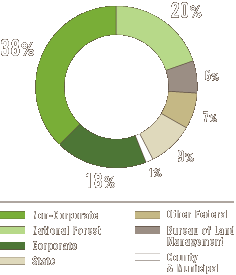Forest Facts
CAN'T SEE THE FOREST FOR WORRYING ABOUT THE TREES
Saving trees requires thinking about them in the context of woodlands and forests, because the more trees there are in one place, the richer the ecological benefits such as wildlife, biodiversity, carbon sequestration and, most importantly, water. Eighty percent of all rain that falls east of the Mississippi River falls on family-owned forests where it is purified, stored and released into aquifers.
It’s not “Can we save a tree?” It’s “Can we save a forest?”
A lot of attention, and progress, has been focused on global deforestation. But what’s happening right here in our back yard?
FORESTS ARE ON THE EDGE
For the first time in 100 years, our U.S. forests are shrinking and disappearing. The smaller the woodland area, the fewer ecological benefits it provides. And those benefits vanish completely when a forest is destroyed for development.
One in five acres of family-owned forestland is owned by someone at least 75 years old.
Nearly 60 percent of these forests are privately owned, and as owners age, this land is being divided, sold and transferred at an alarming rate, often for urban development. The critical question we need to ask is: How can we help private landowners hold on to and sustainably manage these rich ecosystems that supply us with clean air and water?
FOREST LANDOWNERSHIP

A MATTER OF ECONOMICS
Owners of woodlands have to pay taxes. And protecting these woodlands against fire, insects, invasive plants, illegal logging, etc., adds more expense to ownership. When the land can pay for itself with selective harvesting and replanting of portions of these woodlands for timber sales, there’s less chance that a landowner will have to sell to a developer. But when the market for timber goes away, those landowners often don’t have a choice.
55 million acres of forestland are owned by people who plan to sell or transfer some or all of their land in the next five years.
Private family landowners say their primary interests in keeping their woodlands intact are for posterity, recreation and scenic beauty. Growing trees for timber on part of that land is the way they pay the expenses of ownership. Selective harvesting and replanting using advanced forest management practices (called silviculture) not only provides an income, but also creates a healthier woodland that is better protected from wildfires, insects and invasive plants. A full 60% of the wood harvested in the U.S. comes from these family forestlands.
By providing a market for wood, the forest products industry gives forest owners an incentive to keep land as forest as opposed to converting it to other uses that provide few or no watershed or carbon benefits.
(The World Business Council for Sustainable Development, The Sustainable Forest Products Industry, Carbon and Climate Change)
Corporate private owners of forested land operate in an extremely competitive environment with constant pressures to cut costs and improve market share. Unlike individual owners, they typically have no emotional attachment to the land and are concerned first and foremost with profit. If managing the land for timber isn’t profitable, there’s a good chance that development will be. Consider the fact that outside Washington D.C., developers will pay up to $30,000 per acre of forested land. Harvesting timber on that same acre yields only $1,000 – $5,000 each year.